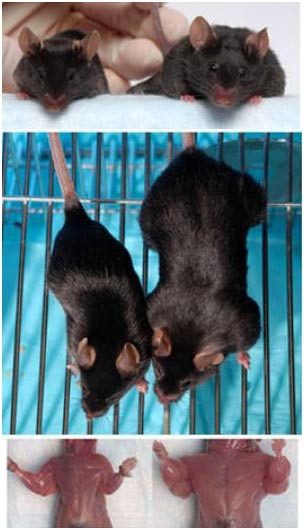'Extraordinary mice' are made more extraordinary
Danh Phuong
Johns Hopkins, the first person to prove myostatin protein deficiency leads to over-sized muscles in mice, and now a second protein, follistatin, has been discovered that excess crisis Its in mice that lack myostatin make doubling the effect of muscle formation.
The results of the new study were carried out by Dr., Doctor of Medicine Se-Jin Lee of the 01 Public Science Library (PloS One), proving that while mice lacking genes to create myostatin have The total muscle mass of the body is nearly twice as high as normal, and the non-myostatin-free animals that produce excess follistatin also have four times more muscle than normal mice.
Lee, a professor of genetics and molecular biology, said this increase in muscle mass significantly increased research efforts to ' increase ' pets or promote muscle growth in these areas. patients with muscular atrophy and disease that gradually wears away health.

The comparison of body and muscle size between normal mice (left) and double mutant mice lacking myostatin protein and excess protein production of follistatin (right) - (Photo by Johns Hopkins Medical Institutions provided)
In particular, Lee discovered follistatin initially, which suppresses the activity of myostatin in muscle cells developed in the laboratory environment . When he introduced this substance into a normal mouse, it became larger, as if myostatin was lost in these animals.
Next, he designed the genetics of a mouse lacking both myostatin and follistatin added. If follistatin at that time only increased muscle growth, Lee was able to surmise that follistatin had no additional effect without the presence of myostatin.
Lee, found that these muscular mice had an average increase of 117% in muscle fiber size and reached an increase of 73% in total muscle fibers compared to normal mice, said: 'I was very surprised and happy, yet another effect.'
'The findings suggest that the capacity to increase muscle growth by targeting this process is much greater than what we know.' Lee added, 'we will now look for other players who work with myostatin, so we can address a great potential to enhance muscle development for applications. clinical use. '
Lee added that the problem is special, since most of the agents are targeting the development process, including a drug being tested in a clinical trial of muscular dystrophy, already Designed only to prevent only myostatin protein, not other related proteins.
The grant for this study was funded by the National Institutes of Health and Muscular Dystrophy Association and a gift from Merck Research Laboratories.
Note: This report is adapted from a news release published by Johns Hopkins Medical Institutions.
- The mole rats eat the mouse rat manure to get instructions for raising children
- Suffering from autism, many geniuses show extraordinary abilities
- The truth is hard to believe: A pair of experimental mice can be as expensive as a billion-dollar car
- Germany: Detecting 3 million-year-old fossil remains red
- New threat from European house mice
- People are able to remember every detail of life
- Scientists have created transparent mice
- Successfully cloned mice from a drop of blood
- Brain damage develops extraordinary abilities
- Cure mice with disabilities by
- Pups born from two gay mice
- 'Super mouse' is as big as a cat because of radiation
 Why do potatoes have eyes?
Why do potatoes have eyes? 'Tragedy' the world's largest carnivorous life: Death becomes ... public toilet
'Tragedy' the world's largest carnivorous life: Death becomes ... public toilet Tomatoes were once considered 'poisonous' for 200 years
Tomatoes were once considered 'poisonous' for 200 years Detecting microscopic parasites on human face
Detecting microscopic parasites on human face